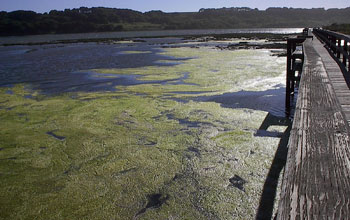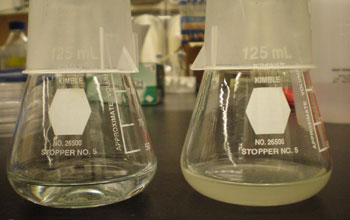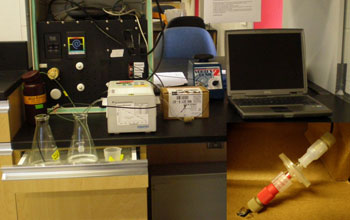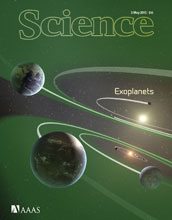
| Superoxide-producing bacteria live in dark places like the depths of Elkhorn Slough, Calif. Credit: Scott Wankel, WHOI |
Download the high-resolution JPG version of the image. (657 KB) |

| Dyes are added to colonies of superoxide-producing bacteria growing on laboratory plates. Credit: Tong Zhang, WHOI |
Download the high-resolution JPG version of the image. (1.3 MB) |

| Bacteria that make superoxide are grown in flasks filled with seawater from ocean depths. Credit: Julia Diaz, WHOI |
Download the high-resolution JPG version of the image. (1.1 MB) |

| Superoxide produced by millions of bacteria is measured by laboratory instruments. Credit: Julia Diaz, WHOI |
Download the high-resolution JPG version of the image. (151 KB) |

| Close-up image of a colony of bacteria shows a dye that that binds only to oxidants. Credit: Tong Zhang, WHOI |
Download the high-resolution JPG version of the image. (190 KB) |

| The researchers' results are described in the May 3rd issue of the journal Science. Credit: Copyright AAAS 2013 |
| Download the high-resolution JPG version of the image. (485 KB) |
Breathing oxygen... can be hazardous to your health?
Indeed, our bodies aren't perfect. They make mistakes, among them
producing toxic chemicals, called oxidants, in cells. We fight these
oxidants naturally, and by eating foods rich in antioxidants such as
blueberries and dark chocolate.
All forms of life that breathe oxygen--even ones that can't be seen with
the naked eye, such as bacteria--must fight oxidants to live.
"If they don't," says scientist Colleen Hansel of the Woods Hole
Oceanographic Institution in Massachusetts, "there are consequences:
cancer and premature aging in humans, death in microorganisms."
These same oxidants also exist in the environment. But neutralizing
environmental oxidants such as superoxide was a worry only for organisms
that dwell in sunlight--in habitats that cover a mere 5 percent of the
planet.
That was the only place where such environmental oxidants were thought to exist.
Now researchers have discovered the first light-independent source of
superoxide. The key is bacteria common in the depths of the oceans and
other dark places.
The bacteria breathe oxygen, just like humans. "And they're
everywhere--literally," says Hansel, co-author of a paper reporting the
results and published in this week's issue of the journal Science Express.
The result expands the known sources of superoxide to the 95 percent of
Earth's habitats that are "dark." In fact, 90 percent of the bacteria
tested in the study produced superoxide in the dark.
"Superoxide has been linked with light, such that its production in
darkness was a real mystery," says Deborah Bronk of the National Science
Foundation's (NSF) Division of Ocean Sciences, which co-funded the
research with NSF's Division of Earth Sciences.
"This finding shows that bacteria can produce superoxide in the absence of light."
The bacteria are found "miles beneath the seafloor, in hot fluids coming
from underwater volcanoes, in every type of underground soil and
throughout deep lake and ocean waters," Hansel says.
The number of these bacteria in a thimble of seawater or soil is greater
than the human population of San Francisco. And they're all releasing
large amounts of superoxide.
On Earth's surface, "superoxide can kill corals, turning them white,"
says Hansel. "It can also produce huge fish kills during red tides. But
it's not always bad."
It also helps ocean microorganisms acquire the nutrients they need to
survive. And superoxide may remove the neurotoxin mercury from the sea,
keeping it out of fish and off dinner plates.
The bacteria that produce superoxide could account for the total amount
of the chemical in the oceans, Hansel and colleagues say, and are likely
the main source in dark environments.
"That's a paradigm shift that will transform our understanding of the
chemistry of the oceans, as well as of lakes and underground soils,"
says Hansel, "and of the life forms that live in and depend on them."
Co-authors of the paper are Julia Diaz and Chantal Mendes of Harvard
University, Peter Andeer and Tong Zhang of Woods Hole Oceanographic
Institution and Bettina Voelker of the Colorado School of Mines.
-NSF-
Media Contacts
Cheryl Dybas, NSF (703) 292-7734 cdybas@nsf.gov
The National Science Foundation (NSF) is an independent federal
agency that supports fundamental research and education across all
fields of science and engineering. In fiscal year (FY) 2012, its budget
was $7.0 billion. NSF funds reach all 50 states through grants to nearly
2,000 colleges, universities and other institutions. Each year, NSF
receives about 50,000 competitive requests for funding, and makes about
11,500 new funding awards. NSF also awards about $593 million in
professional and service contracts yearly.
Useful NSF Web Sites:
NSF Home Page: http://www.nsf.gov
NSF News: http://www.nsf.gov/news/
For the News Media: http://www.nsf.gov/
Science and Engineering Statistics:http://www.nsf.gov/
Awards Searches: http://www.nsf.gov/
The National Science Foundation (NSF)
Guillermo Gonzalo Snchez Achutegui
ayabaca@gmail.com
ayabaca@hotmail.com
ayabaca@yahoo.com
Inscríbete en el Foro del blog y participa : A Vuelo De Un Quinde - El Foro!

No hay comentarios:
Publicar un comentario